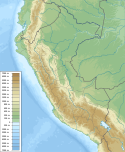Pisco Basin
| Pisco Basin | |
|---|---|
| Cuenca de Pisco | |
| Coordinates | 14°15′S 76°0′W / 14.250°S 76.000°W |
| Etymology | City of Pisco, Peru |
| Location | Western South America |
| Country | |
| State(s) | Ica Region |
| Cities | Pisco |
| Characteristics | |
| On/Offshore | Both |
| Part of | Circum-Pacific forearc basins |
| Area | 300 km (190 mi) |
| Hydrology | |
| Sea(s) | Eastern Pacific Ocean |
| River(s) | Pisco River |
| Geology | |
| Basin type | Forearc basin |
| Orogeny | Andean |
| Age | Eocene–Pliocene |
| Stratigraphy | Stratigraphy |
Pisco Basin (Spanish: Cuenca de Pisco) is a sedimentary basin extending over 300 kilometres (190 mi) in southwestern Peru.[1] The basin has a 2 kilometres (6,600 ft) thick sedimentary fill, which is about half the thickness of more northern foreland basins in Peru.[2]
The oldest known sediments are the Eocene sandstones of the Caballas Formation, while the youngest deposits, the fossiliferous Pisco Formation, date to the Early Pleistocene.[2][note 1] In relation to present-day, topography the fill of Pisco Basin makes the upper part of the Coastal Cordillera of southern Peru, the coastal plains, the Ica-Nazca Depression and the Andean foothills.[3]
The basin is renowned for hosting various highly fossiliferous stratigraphic units; the Pisco Formation has provided a wealth of marine mammals (including sloths), birds, fish and other groups, as have the Chilcatay, Otuma and Yumaque Formations.
Stratigraphy
| Age[2][5] | SALMA[note 3] | Units[2][5] | Environment[2][5] | Lithology[2][5][6] | |
|---|---|---|---|---|---|
| Pleistocene | Uquian | Pisco | Lagoonal to near-shore | Bioclastic conglomerate, sandstone | |
| Middle Miocene | Colloncuran | ||||
| Early Miocene | Colhuehuapian | Chilcatay | Marine | Siltstone, sandstone | |
| Late Oligocene | Deseadan | ||||
| Early Oligocene Late Eocene |
Tinguirirican Divisaderan |
Otuma | Marine embayment | Bioclastic sandstone, sandstone, silty sandstone, mudstone, dolomitic sediment | |
| Late Eocene | Divisaderan | Paracas | Yumaque | Mudrock, phosphatic shale, diatomite, porcellanite, chert | |
| Late Eocene | Mustersan | Los Choros | Inner shelf, shoreface, intertidal | Bioclastic conglomerate, sandstone, siltstone, mudrock | |
| Eocene | Casamayoran | Caballas | Fluvial | Sandstone, tuff, coal | |
Tectonic and sedimentary evolution
The basin developed in a setting of extensional tectonics from Eocene to the Late Miocene with short-lived episode of basin inversion in the Middle Miocene.[7] Late Pliocene and Pleistocene uplift of the basin may be consequence of the subduction of Nazca Ridge.[2][8]
Sedimentary strata of the basin shows evidence for a series of marine transgressions during the last 50 million years.[9] These marine transgressions occurred in a sequence 41-34 Ma, 31-28 Ma, 25-16 Ma, 15-11 Ma, 10-5 Ma, and 4-2 Ma.[9] The end of most of the marine transgressions is thought to be associated either with global sea level falls or compressional events in the Andes.[9]
Oligo-Miocene transgression
The marine Oligo-Miocene (25–16 Ma[9]) marine transgression is evidenced by a series of sedimentary strata containing fossils of marine diatoms, Peruchilus snails and Pitar and Cucullaea clams.[10] Oligo-Miocene marine environments in the Pisco Basin range from littoral to shelf.[10] Moquegua Basin southeast of Pisco Basin appear to have been unaffected by the transgression.[10]
Within the Andean margin contemporary marine transgressions are also known from southern Chile, Patagonia and Colombia.[10] As such the marine transgression is thought to represent a regional phenomenon with the steadily rising central Andes being an exception.[10]
Paleontology
Pisco Formation
Chilcatay Formation
Otuma Formation
| Group | Fossils | Notes |
|---|---|---|
| Mammals | Cynthiacetus peruvianus, Basilosauridae indet. | |
| Birds | Icadyptes salasi, Inkayacu paracasensis, Spheniscidae indet. | |
| Fish | Engraulis sp., Sardinops sp. |
Paracas Group
| Group | Fossils | Notes |
|---|---|---|
| Mammals | Ocucajea picklingi, Supayacetus muizoni, Basilosauridae indet. | |
| Birds | Perudyptes devriesi |
Yumaque Formation
| Group | Fossils | Notes |
|---|---|---|
| Mammals | Mystacodon selenensis |
See also
- Arauco Basin, Chile
- Altiplano Basin, Peru, Chile, Bolivia
- Caldera Basin, Chile
- Cocinetas Basin, Colombia
- Urumaco Formation, Venezuela
Notes and references
Notes
- ^ later publications give a younger top date
- ^ Based on "DeVries (1998) as presented by León et al. (2007)"[4]
- ^ See SALMA Bibliography for sources
References
- ^ Solís Mundaca, 2018, p.1
- ^ a b c d e f g Dunbar et al., 1990
- ^ León et al. 2007, p. 7.
- ^ León et al. 2007, p. 44.
- ^ a b c d DeVries et al., 2017
- ^ León et al. 2007, p. 45.
- ^ León et al. 2007, p. 146.
- ^ León et al. 2007, p. 145.
- ^ a b c d DeVries, 1998
- ^ a b c d e Macharé et al., 1988
- ^ a b Ullujaya at Fossilworks.org
- ^ Ullujaya 2 at Fossilworks.org
- ^ a b Santa Rosa at Fossilworks.org
- ^ a b Zamaca at Fossilworks.org
- ^ Cerro Buque M2 at Fossilworks.org
- ^ Cerro Buque M8 at Fossilworks.org
- ^ Paracas Bay at Fossilworks.org
- ^ Archaeocete Valley, Otuma, AV-10 at Fossilworks.org
- ^ Ullujaya Valley at Fossilworks.org
- ^ Bajada del Diablo at Fossilworks.org
- ^ a b Paracas Reserve at Fossilworks.org
- ^ Archaeocete Valley at Fossilworks.org
- ^ Archaeocete Valley, Paracas, AV-17 at Fossilworks.org
- ^ Archaeocete Valley, Paracas, AV-19 at Fossilworks.org
- ^ Quebrada Perdida at Fossilworks.org
- ^ Lambert et al., 2017
Bibliography
- Stratigraphy
Geology publications
Paleontology publications
Further reading
- Chilcatay Formation
- Paracas Group
- Pisco Formation


